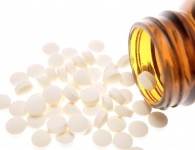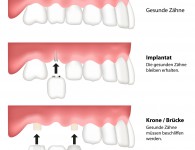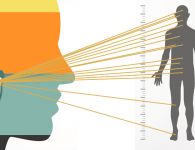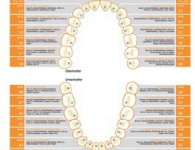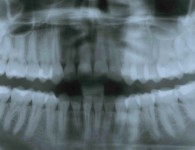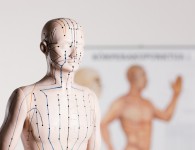- You wish to have a near natural tooth reconstruction but have insufficient bone tissue? We offer a range of possibilities to ensure a gentle restoration of bone tissue for maximum implant stability.
- Once a tooth has been extracted, the surrounding bone tissue strats to shrink due to lack of pressure, similar to muscle tissue wasting under a plaster cast. Aggravation caused by misplaced stress through chewing and dormant infections of the mandibular bone can also lead to bone loss.
- Dental implantology has developed into a reliable and clinically safe routine procedure for patients with sufficient bone tisssue. In cases where the bone tissue is insufficient the latter must first be established in order to provide the implant with adequate support and stability. Various materials are available for this purpose. After the healing process is complete and the ossification is well advanced the implant can be put in place.
- From a holistic point of view endogenic material is preferable, as the body’s own tissue is 100% compatible. Before undergoing any treatment inform yourself about which material will be implanted in your body – environmental medicine.
- The body´s own bone is the „golden standard“ in the field of bone augumentation. Bone harvesting is carried out on the premises in the surgery-OP and is primarily possible from the upper and lower mandible. In the case of a major bone defect harvesting is carried out from the pelvic crest; this operation is carried out under general anaesthetic in our private clinic. An alternative possibility is the cultivation of donor bone material. This has the advantage of sparing the patient an extra oral operation – the bone deficiency is compensated during the first session. Before the wound is closed a membrane, made from autologous blood. This own-blood has a high concentration of growth factors and thus otimizes the bone tissue healing process.
- After the healing process is complete the implant can be set without any difficulty and the temporary crown can be fitted.
- Depending on the initial situation the donor bone tissue may additionally be impregnated with an antibiotic layer. This enables a 5.000 times higher dosis to be directed at the target area without the adverse effects on the digestive tract. Over the years this solution has proved to be highly successful in the treatment of mandibular ostitis/osteomyelitus.
Foto: histological section of an integrated donor bone from Univ. Prof. Dr. H. Plenck, Institut für Histologie und Embryologie der Medizinischen Universität Wien. Copyright by Dr. S. Doettelmayer.






